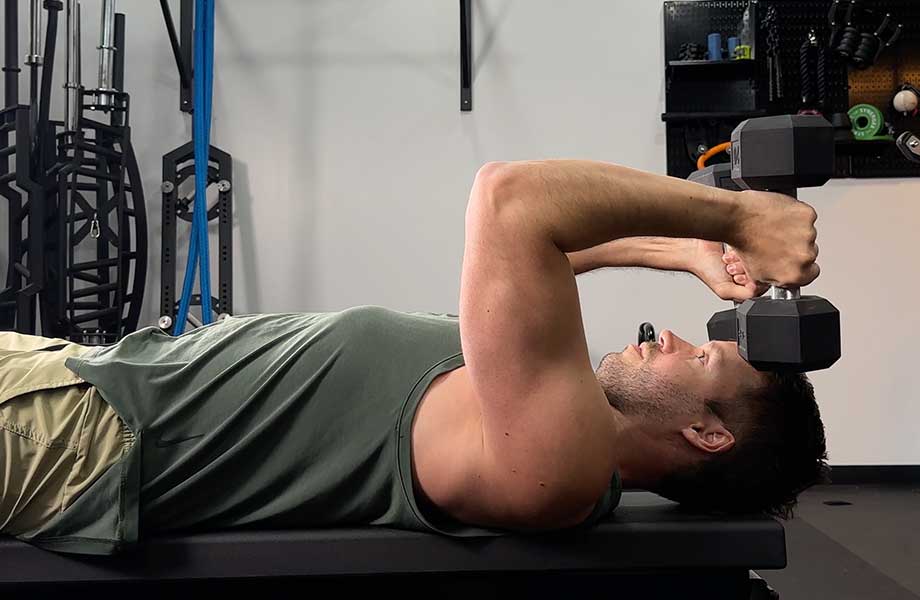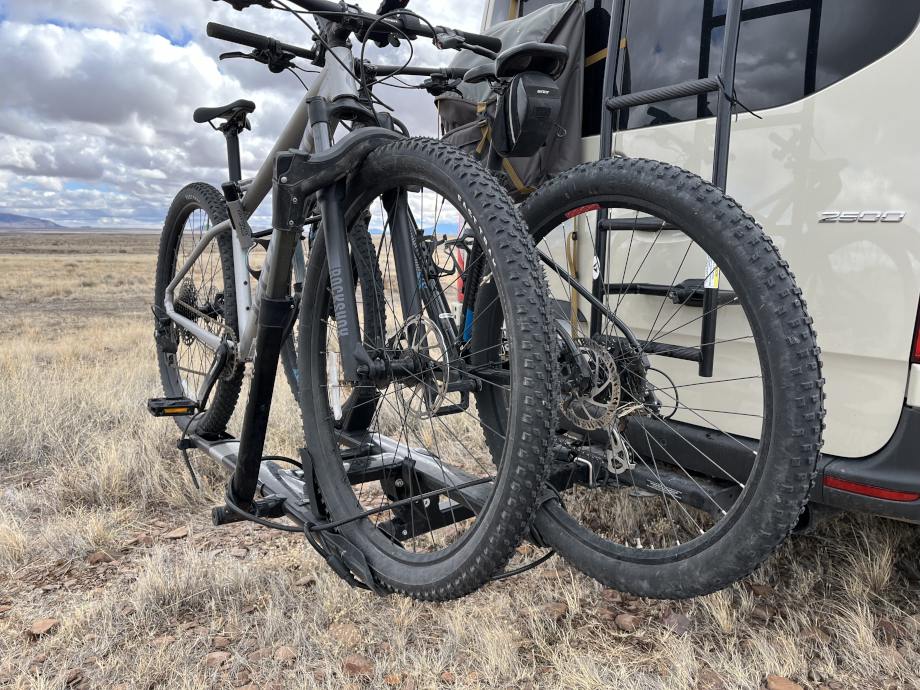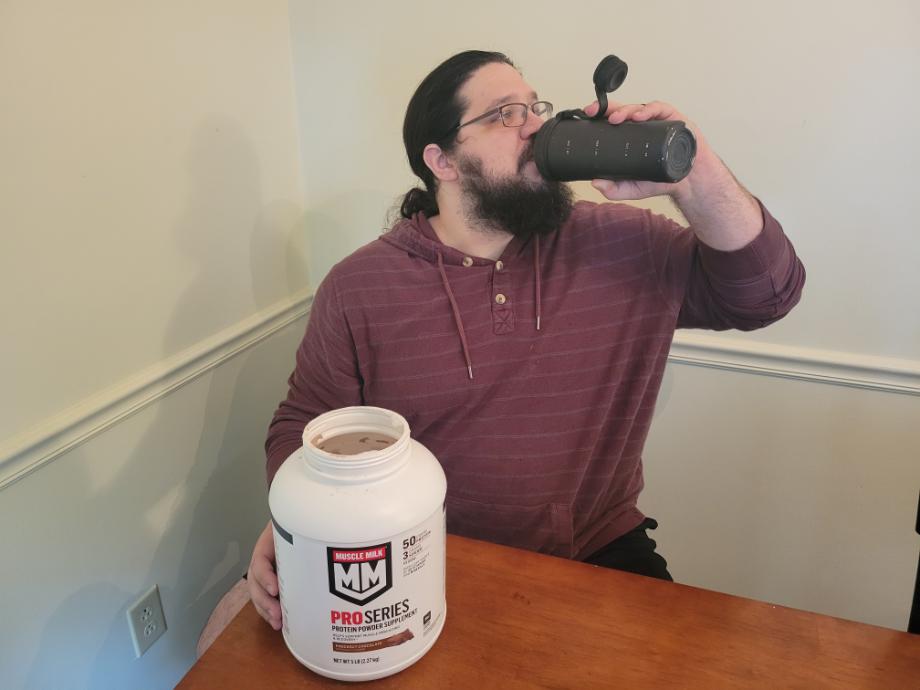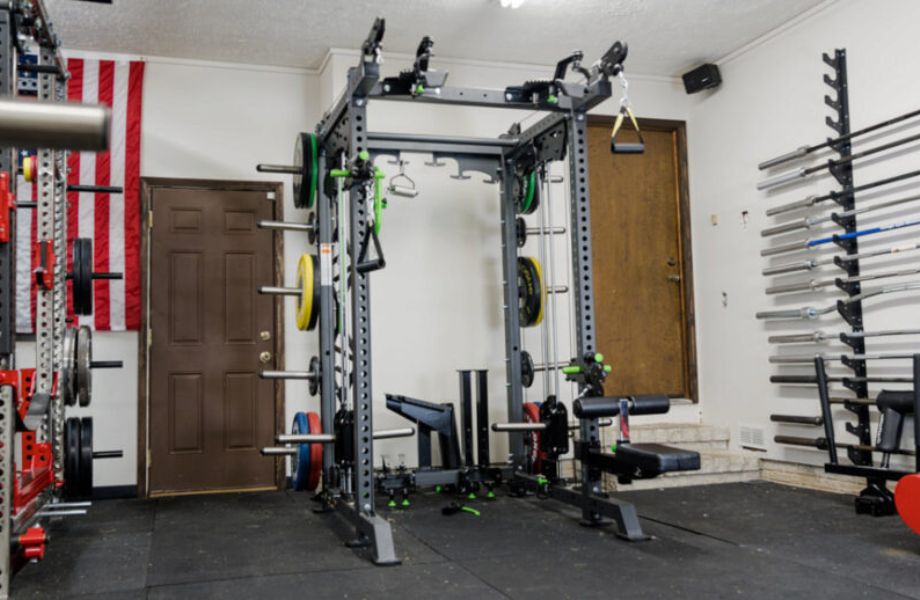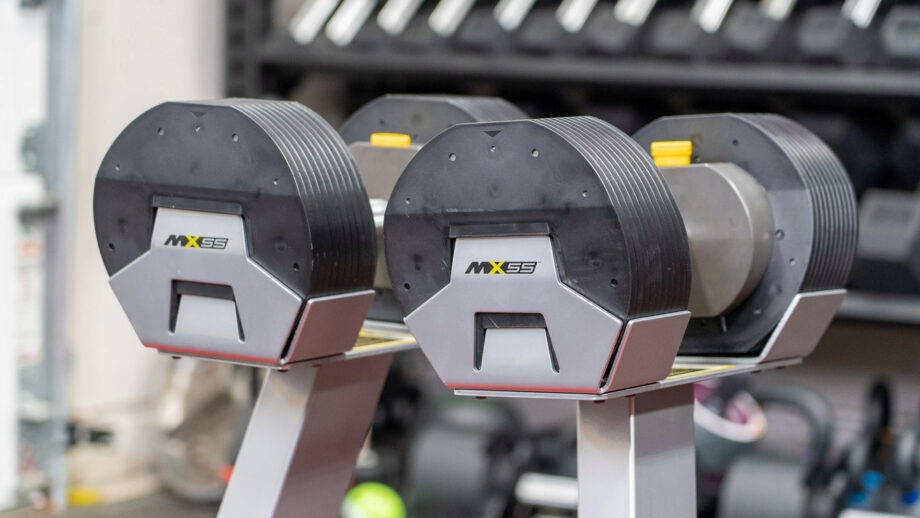Lifting stuff, holding stuff, carrying stuff, pushing stuff—your triceps contribute to everyday functional movements such as these and more. They also assist sport-specific movements, which will help you both in the weight room and on the playing field.
Beyond the functional benefits, many fitness enthusiasts seek the best triceps workouts for aesthetic purposes. A meaty horseshoe triceps muscle is an essential for competitive bodybuilders, but some folks just want to look and feel their best when they go without sleeves.
Whatever your personal reasons for training your triceps, you’ll need a comprehensive plan to target and build them, and these dumbbell triceps workouts are just the thing. We asked Jarrod Nobbe, MA, CSCS, and USAW National Level Coach to take the experience he’s gained in the weight room over the last decade and a half and provide you with fun, challenging, and effective dumbbell triceps exercises to add to your gym routine.
Triceps Anatomy
The triceps brachii1 is a muscle that stretches the length of the back of the arm between the shoulder and elbow joints. Primarily, your triceps enable elbow extension and help keep your elbow joint stabilized when performing smaller hand movements like writing or typing.
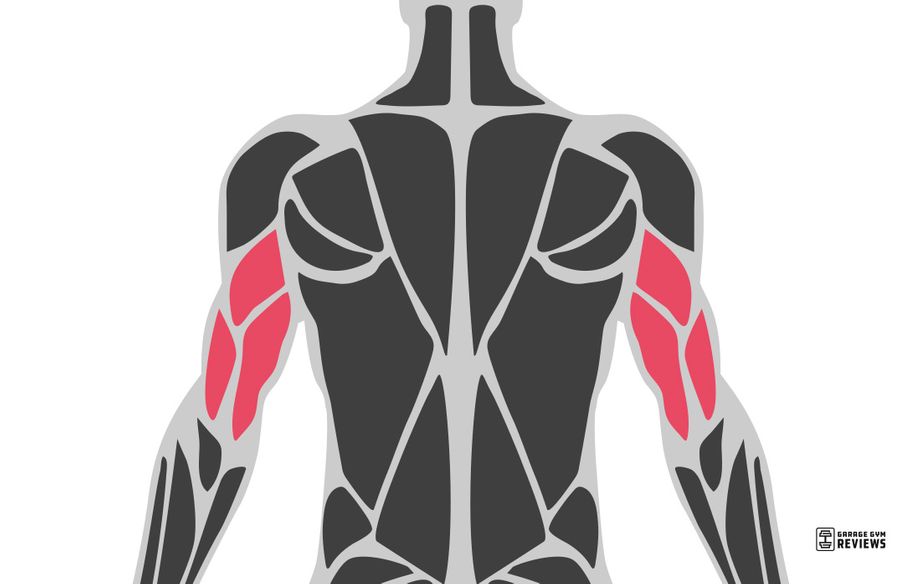
Although it’s only one muscle, the triceps brachii consists of three heads:
- The long head, located on the inside of your arm
- The lateral head, located on the outside of your arm
- The medial head, sitting dead center
Below is a quick chart of how you may cater your tricep training to target each head of the triceps effectively:
| Triceps Head | Long Head | Lateral Head | Medial Head |
| Grip Type | Overhand | Neutral | Reverse |
| Rep Range | Low to High | Low to High | High |
You’ll want to vary the types of triceps exercises you use if you want equal activation across all three heads, but how do you know which head you’re hitting when you work out?
According to a 2018 study published in Acta Orthopaedica et Traumatologica Turcica2, it mostly depends on what your shoulder joint is doing.
Results showed that “At 0-degree shoulder elevation, the long head of the triceps brachii generates a significantly higher muscle force and muscle activation than the lateral and medial heads,” while the medial head of the triceps ran the show “at 90 degrees, 135 degrees, and 180-degree shoulder elevation.”
In case you’re wondering, zero degrees means your arm is at your side with your fingers pointing to the floor, while 180 degrees refers to your arm raised directly overhead.
7 Best Dumbbell Triceps Exercises
So, are you ready to start targeting your triceps to get those gains? Grab yourself a pair of the best dumbbells and let’s get to work!
Overhead Standing Triceps Extension
Why it’s great: The standing dumbbell overhead triceps extension isolates the triceps, inspiring arm muscle growth. You can also perform this exercise with a single arm to correct imbalances.
How to do it:
- Stand with your feet approximately hip-width apart, grab a dumbbell, and hoist it directly overhead. You may choose to do one arm at a time or both by holding the dumbbell with both hands at one end.
- With your back straight, core tight, and knees slightly bent, slowly lower the weight behind your head by bending your elbows. Your upper arms should be in a vertical position and remain perfectly still throughout the range of motion.
- Pause at the end, then push the dumbbell back over head by reversing the motion.
- Repeat as needed.
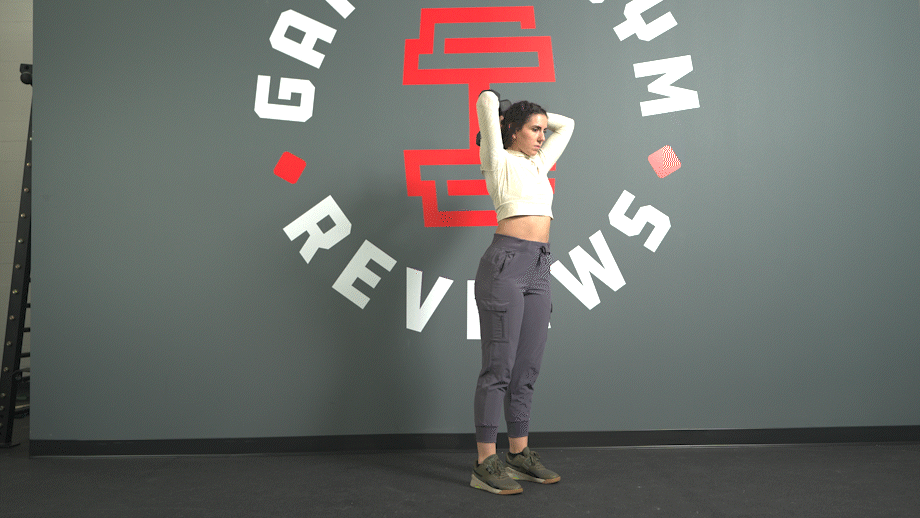
Overhead Seated Triceps Extension
Why it’s great: While the triceps extension is considered an isolation exercise, performing it standing requires you to use your lower body and core to stabilize your body as you lift. Sitting down eliminates that, keeping the focus where it should be—on your triceps!
How to do it:
- Sit at the end of a bench with a single dumbbell held overhead with your arm (or arms) fully extended. Again, you may perform the exercise with a single arm or both simultaneously.
- Bend your elbows to lower the weight behind your head.
- Return the dumbbell to the overhead position by reversing the motion.
- Repeat as needed.
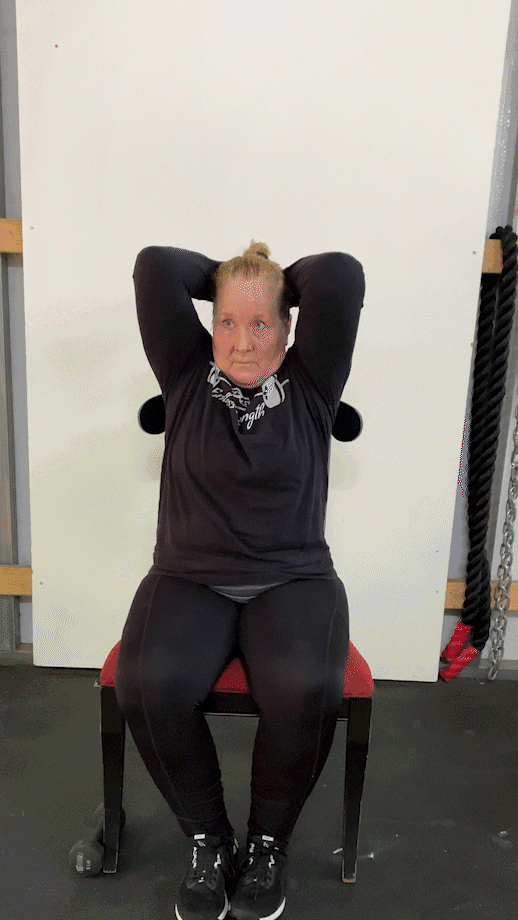
Bent-Over Dumbbell Triceps Extension (Triceps Kickback)
Why it’s great: Dumbbell kickbacks feel difficult, even at lighter weights, because the working arm is held away from the body. It’s challenging, but the movement really isolates the triceps muscles, making it well worth the struggle.
How to do it:
- Grab two dumbbells and hold them at your side with your elbows forming 90-degree angles. Lean your torso forward, maintaining a flat back, until your chest is nearly parallel with the floor.
- Extend your elbows fully, squeezing the triceps muscles in the end position.
- Bring the dumbbells back by reversing the movement.
- Repeat as needed.
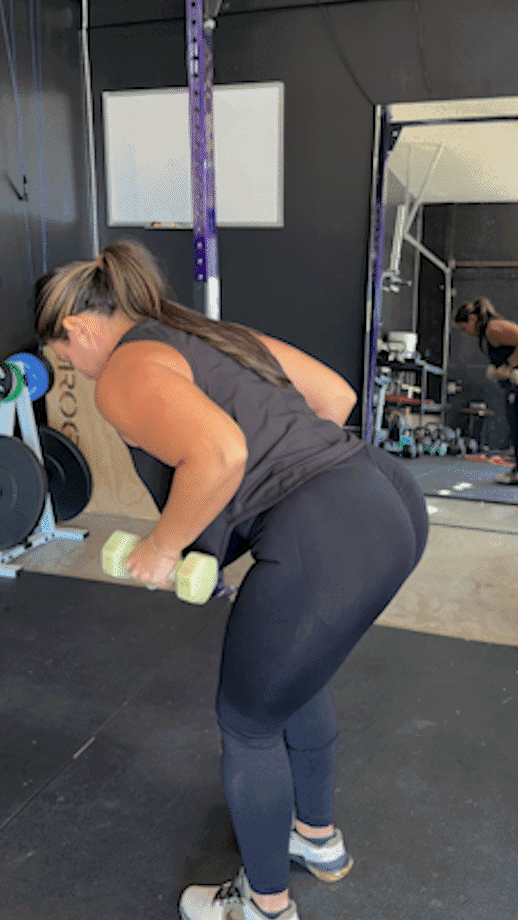
Dumbbell Pullovers
Why it’s great: Dumbbell pullovers make a great addition to a triceps-focused workout routine, but then again, they work for most strength training splits since they provide activation in the chest, back, arms, glutes, and core.
How to do it:
- Lie on a flat bench, holding a dumbbell with both hands directly over your chest. Your feet should be firmly planted to the floor, and your upper back and shoulder blades should be pressed into the bench.
- Lower your arms back and behind your head until they point to the wall behind you. Keep a slight bend in your elbows to protect them from hyperextension.
- Bring the dumbbell back to the starting position.
- Repeat as needed.
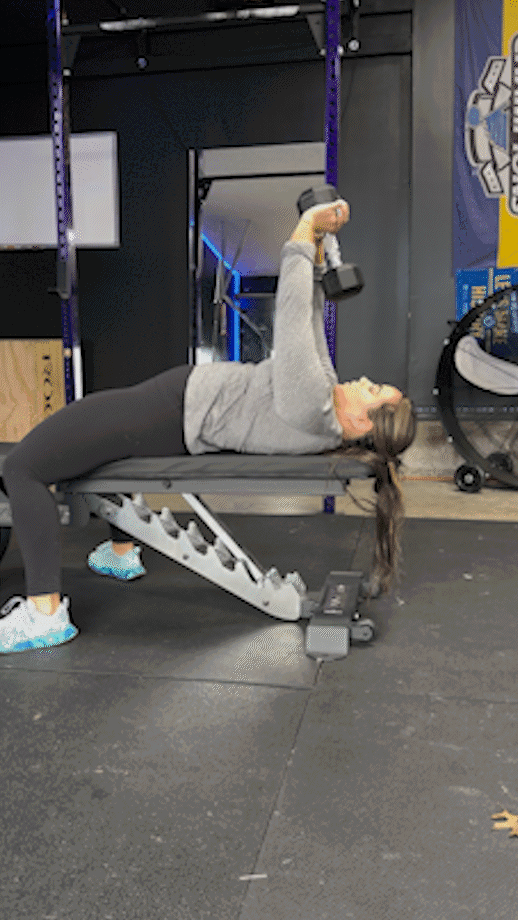
Dumbbell Skullcrushers
Why it’s great: This triceps exercise is sometimes called the “lying triceps extension,” but doesn’t skullcrusher sound way cooler? The positioning seems precarious, but it allows you to move more weight than similar triceps exercises, helping you really get those gains!
How to do it:
- Lie on a flat bench holding two dumbbells over your face. You want your palms facing each other (neutral grip) and elbows bent slightly in the starting position.
- Slowly lower the weights toward your face until they are roughly next to your ears. Hold your upper arms stationary throughout the full range of motion.
- Return the weights to the starting position by reversing the movement.
- Repeat as needed.
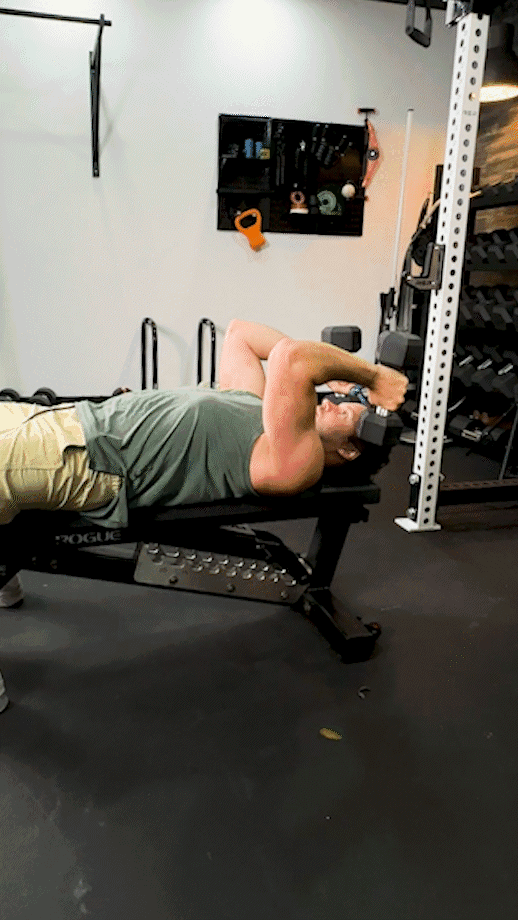
Dumbbell Close-Grip Bench Press
Why it’s great: The close-grip dumbbell bench press is a compound movement that hits muscle groups all throughout the upper body, including the triceps. According to StatPearls1, “the closer the grip…the more the movement will isolate the triceps.”
How to do it:
- Sit on the end of a flat bench with a dumbbell in each hand, resting them on your thighs.
- Lie back, using your legs to push the dumbbells over your chest. Your arms should be fully extended, elbows slightly bent and tucked to your torso, and hands closer than shoulder width to one another.
- Slowly lower the dumbbells to your chest until your elbows are in line with your torso.
- Hold briefly, then push the dumbbells back up. Squeeze your pecs at the end.
- Repeat as needed.
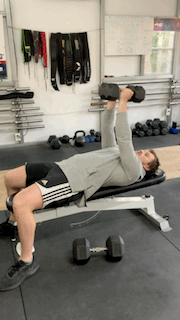
Deficit Push-Up on Dumbbells
Why it’s great: Push-ups are already the quintessential bodyweight movement for building full-body strength because they emphasize the chest, front delts, and triceps. Increasing the range of motion, thanks to the deficit, will make this movement even more effective.
How to do it:
- Grab two dumbbells and place them approximately shoulder width apart on the floor. You may place them down with both ends on the floor and grip the handles with a neutral grip, or you may stand them straight up and place your palm on the dumbbell end for an even greater deficit.
- Step your legs back behind you to enter the push-up position.
- Lower your body to the floor with control by bending your elbows. Keep the elbows tucked in tight to the torso.
- Push your body back up to the starting position, squeezing your triceps at the top.
- Repeat as needed.

RELATED: What Muscles Do Push-ups Work?
How to Incorporate Triceps Exercises Into Your Workouts
We’ve provided a list of the best dumbbell exercises for training your triceps, but where do we go from here?
First, let’s talk frequency. You may feel motivated to hit those tris day after day in pursuit of bigger triceps, but you’ll probably only hinder your success if you don’t rest up in between sessions.
According to a 2017 study published in Muscle & Nerve3, the triceps brachii was not considered capable of producing the same level of force until approximately 48 hours after training. For that reason, we recommend penciling in a triceps workout no more than once every three days.
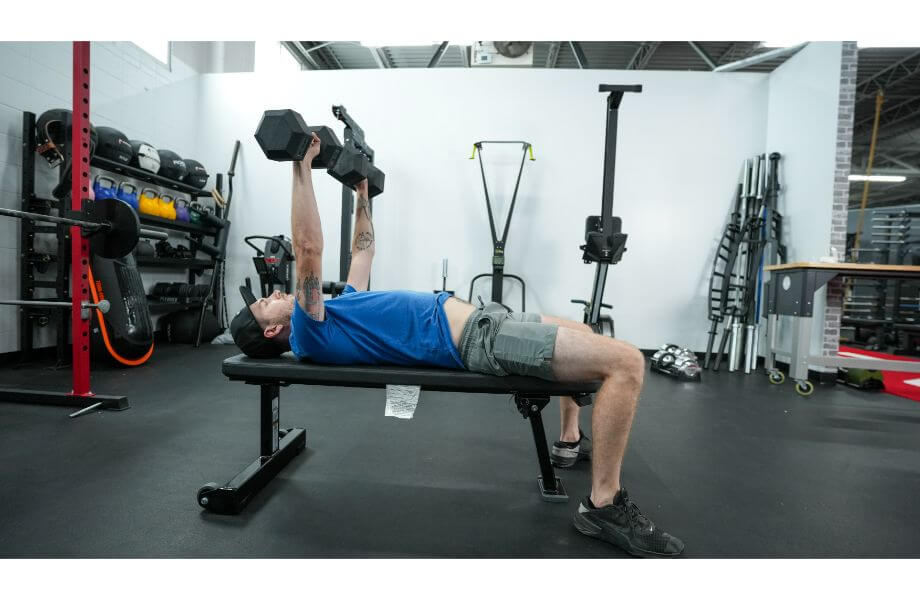
When it comes to how you train them, specifically, you have options.
A “triceps only” day works to keep the focus on this one specific muscle. You can also combine our dumbbell exercises above with other great triceps movements, like the triceps pushdown and triceps dips.
Combining them with your biceps and forearms training for a full-on arm day also works well. Likewise, the triceps form a synergistic pair with the chest, making a designated chest and triceps workout day an intuitive training split.
Best Dumbbell Triceps Workouts
These dumbbell triceps workouts will put you on the path to developing those horseshoe-esque triceps you’ve been chasing ever since you stepped foot in the gym. Jarrod Nobbe, MA, CSCS, and USAW National Level Coach, used research-backed exercises and years of experience to mold the best dumbbell triceps exercises into three workouts to bolster your strength and build muscle.
RELATED: Best Triceps Workouts
Beginner Dumbbell Triceps Workout
This beginner-friendly dumbbell triceps workout emphasizes strength and hypertrophy with tailored rep ranges, providing a targeted session for triceps development. The sequence of exercises engages all three triceps heads, starting with compound movements and gradually transitioning to more single-arm isolation exercises. To cap it off, high-volume sets of close-grip push-ups, a proven triceps-targeting exercise, serve as an effective finisher.
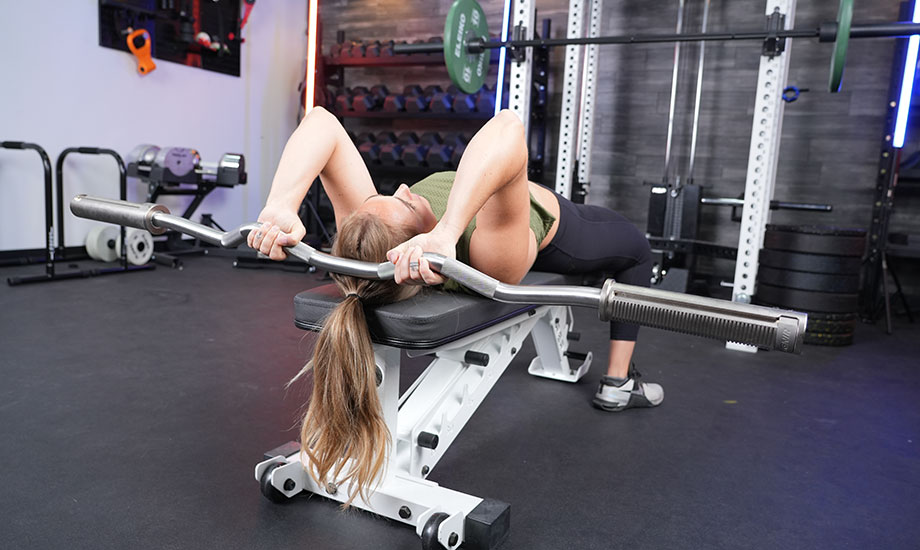
Take note: always start lighter and work your way to heavier loads. Stick to the prescribed tempos and work through a full range of motion to drive greater muscle hypertrophy. Rest periods should be kept around two minutes.
| Exercise | Sets | Reps | Tempo | Notes |
| Close-Grip Dumbbell Bench Press | 2 2 | 8 12 | :03 Lowering* | Perform the sets of 12 with a lighter weight |
| Dumbbell Skull Crusher | 3 | 12-15 | :03 Lowering* | |
| Incline Dumbbell Triceps Kickbacks | 3 | 12-15 | No tempo | |
| Close-Grip Dumbbell Push-up | 3 | 15+ | No tempo | Aim for 15 reps or more |
*Take three seconds to lower the dumbbells from the starting position of the lift for each repetition.
RELATED: Skull Crusher Workout
Muscle-Building Dumbbell Triceps Workout
This workout hangs out in the world of higher rep sets and drop sets to failure, proven methods to boost muscle growth. A December 2019 systematic review by the International Journal of Environmental Research and Public Health4 concluded that completing sets of 8 to 12 repetitions is optimal for muscular hypertrophy and further mentioned higher rep sets of lighter loads create similar results in hypertrophy when taken to volitional fatigue (failure).
This workout begins with compound exercises and finishes with isolated movements, enhancing your muscle-building potential. Start with moderate weight, maintaining it across sets (drop sets to failure will have you reduce weight). Gradually increase the weight each week to progress effectively. Rest periods5 should be kept shorter, roughly one minute, to optimize muscle hypertrophy.
| Exercise | Sets | Reps | Notes |
| Close-Grip Dumbbell Push-up | 3 2 | 8-12 15+ | Aim for 15 reps or more |
| Reverse-Grip Dumbbell Bench Press | 3 1 | 8-12 15+ | Aim for 15 reps or more |
| Dumbbell Overhead Triceps Extension | 3 1 | 8-12 15+ | Aim for 15 reps or more |
| Bent-Over Dumbbell Triceps Kickback | 3 1 | 8-12 15+ | Aim for 15 reps or more |
Strength-Building Dumbbell Triceps Workout
Looking to push your bench and strict press PRs to new heights? Don’t underestimate the role of smaller muscle groups, such as the triceps, in boosting these key lifts. Focusing on triceps strength can be a game-changer for achieving new levels in your performance. If you’re unsure of where to start, look no further than this triceps strength-building routine.
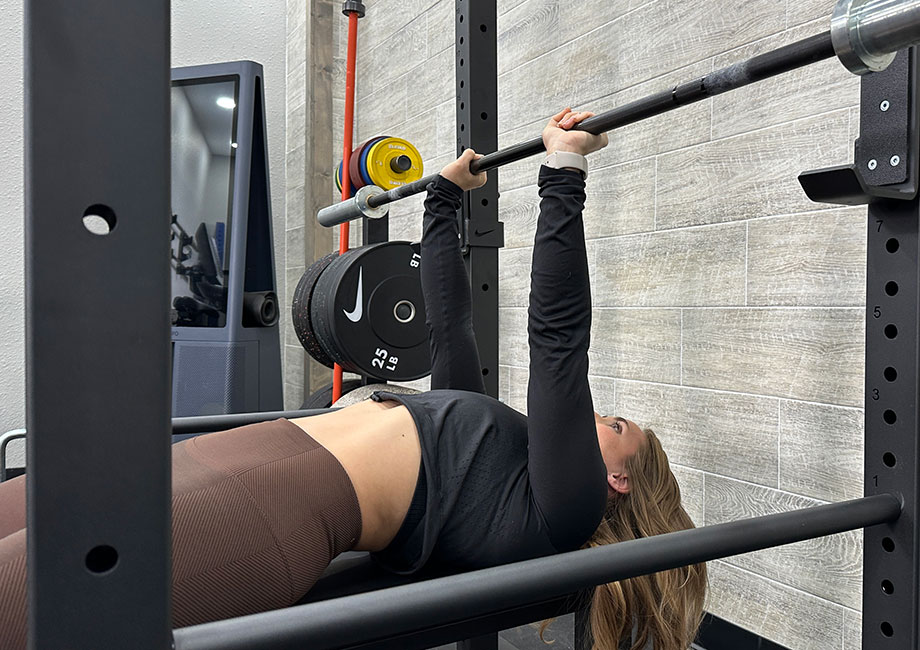
You’ll start by crushing a few compound strength lifts, followed by isolating the triceps for well-rounded development. Rather than using straight sets at the same weight, you’ll increase weight set-to-set as the reps lower in volume. Keep the rest periods to two minutes for optimal recovery for strength-based training.
| Exercise | Sets | Reps | Notes |
| Incline Dumbbell Close-Grip Bench Press | 2 2 | 8 6 | Increase weight for the sets of 6 |
| Seated Reverse-Grip Dumbbell Shoulder Press | 2 2 | 8 6 | Increase weight for the sets of 6 |
| Dumbbell Skull Crusher | 2 2 | 12 8 | Increase weight for the sets of 8 |
| Dumbbell Tate Press | 2 2 | 12 8 | Increase weight for the sets of 8 |
Benefits of Dumbbell Triceps Workouts
Dumbbell triceps workouts offer a versatile and effective means to develop your triceps while promoting elbow health and stability6. These exercises not only contribute to developing strong and defined triceps but also enhance overall upper-body strength. The controlled movements involved in dumbbell exercises engage the triceps while simultaneously improving the stability and function of the elbow joint, making them invaluable for both aesthetic gains and functional fitness.
Build More Defined Triceps
Dumbbell tricep workouts are effective in building bigger arms through targeted compound and isolation exercises. Dumbbell workouts focus specifically on the triceps, engaging and stressing the muscles effectively by utilizing various movements like presses, extensions, and kickbacks. This stimulates muscle growth and strength development.
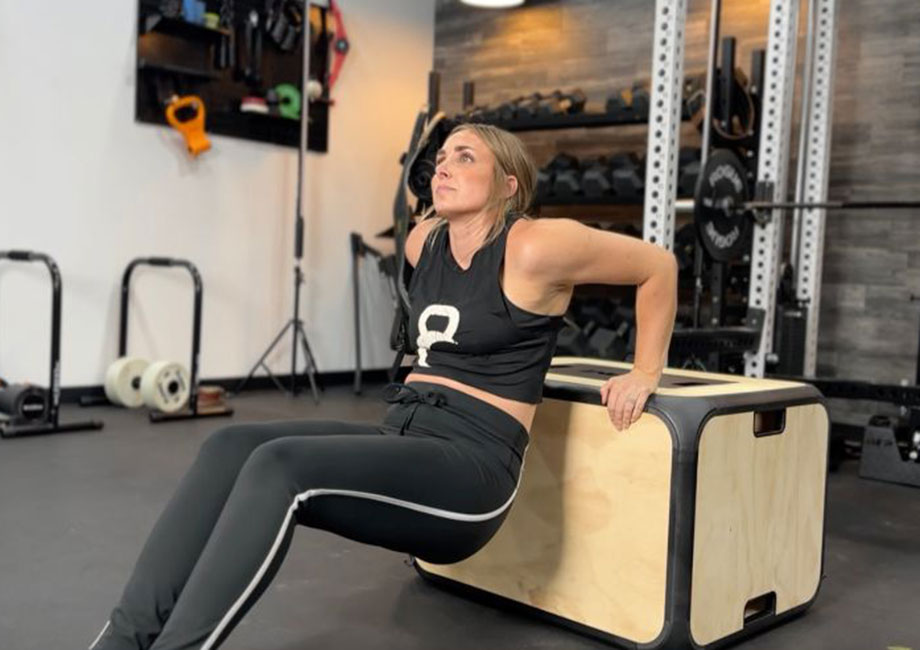
Additionally, using dumbbells allows for a wide range of motion, ensuring maximal muscle activation and promoting both strength and definition in the triceps. Regularly challenging the triceps with progressive overload (increasing weight or volume) through dumbbell exercises encourages muscle adaptation and growth6, ultimately leading to stronger, more defined triceps over time.
Promote Elbow Health and Stability
Dumbbell tricep workouts contribute to elbow joint health and stability through several methods. These exercises involve controlled movements that engage the triceps while also recruiting supporting muscles and stabilizers around the elbow. Strengthening the triceps aids in stabilizing the elbow joint during various movements, enhancing its overall stability and indirectly strengthening the tendons and ligaments around the elbow. Developing your triceps provides added support and reduces your risk of injury. Consistent training with dumbbell exercises also improves muscle coordination and balance, further contributing to overall joint health and stability in the elbow.
Dumbbell Triceps Workouts: FAQs
Can you work triceps with dumbbells?
Some lifters believe that, unless you’re knocking out reps with a barbell, you’re not doing enough work to really build muscle. As it would turn out, that couldn’t be further from the truth.
A 2017 study published in the Journal of Strength and Conditioning Research7 compared strength performance and muscle activation during the bench press and triceps extension exercises when using either a barbell, dumbbells, or a Smith machine. The results varied, with each training modality providing some upside over the others, but dumbbells emerged the clear victor in terms of muscle activation and total number of repetitions.
Applying what we know about rep schemes and their role in muscle gain, we have the optimal formulas for building muscle size and endurance in our guide on how many reps to build muscle.
What are the best dumbbell triceps exercises?
Plenty of compound exercises provide activation in the triceps, but the best triceps exercises either isolate the muscle or feature it as a prime mover.
Those exercises include:
– Standing overhead triceps extension
– Seated overhead triceps extension
– Triceps kickbacks
– Dumbbell pullovers
– Dumbbell skull crushers
– Close-grip dumbbell press
– Deficit push-ups on dumbbells
If you’re searching “What is the number one triceps exercise?” you’re bound to run into one of the movements listed above.
Beginners should pick two or three at first, while those with more proficiency may feel free to include as many as they feel comfortable doing at once.
Should I do 2 or 3 triceps exercises?
Performing two to three exercises for your triceps is a great starting point. Aim for two to four movements per muscle group within your weekly program, ensuring effective distribution. Avoid excess sets and reps, which might lead to unnecessary training volume, or what Jarrod Nobbe, MA, CSCS, and USAW National Level Coach, likes to call “junk volume.”
Vary your exercises to target different parts of the triceps, maximizing muscle engagement. In an August 2020 study in the International Journal of Exercise Science8, researchers found that varying the angles at which you train movements helps “maximize the training stimulus as it relates to muscle growth and strength gains.”
What triceps exercise hits all 3 heads?
Most triceps-focused exercises—like the close-grip bench press, skull crusher, and triceps pushdown—work all three heads of the triceps, but the level of shoulder elevation will determine which is doing the most work.
When in doubt, consult a qualified fitness professional and they’ll clarify what head is leading each exercise.
Do hammer curls work triceps?
While hammer curls primarily target the biceps, they do involve the triceps in a minor-supporting role. During the downward phase of the exercise, the triceps stabilize the elbow. To engage the triceps more, focus on a controlled descent while lowering the weight after the curl.
RELATED: How to Do Hammer Curls
References
1. Tiwana MS, Sinkler MA, Bordoni B. Anatomy, Shoulder and Upper Limb, Triceps Muscle. [Updated 2022 Aug 30]. In: StatPearls [Internet]. Treasure Island (FL): StatPearls Publishing; 2023 Jan
2. Kholinne E, Zulkarnain RF, Sun YC, Lim S, Chun JM, Jeon IH. The different role of each head of the triceps brachii muscle in elbow extension. Acta Orthop Traumatol Turc. 2018;52(3):201-205. doi:10.1016/j.aott.2018.02.005
3. Ferreira DV, Gentil P, Soares SRS, Bottaro M. Recovery of pectoralis major and triceps brachii after bench press exercise. Muscle Nerve. 2017;56(5):963-967. doi:10.1002/mus.25541
4. Krzysztofik M, Wilk M, Wojdała G, Gołaś A. Maximizing Muscle Hypertrophy: A Systematic Review of Advanced Resistance Training Techniques and Methods. Int J Environ Res Public Health. 2019;16(24):4897. Published 2019 Dec 4. doi:10.3390/ijerph16244897
5. de Salles BF, Simão R, Miranda F, Novaes Jda S, Lemos A, Willardson JM. Rest interval between sets in strength training. Sports Med. 2009;39(9):765-777. doi:10.2165/11315230-000000000-00000
6. National Center for Biotechnology Information. Anatomy, Shoulder and Upper Limb, Arm Triceps (Triceps Brachii). In: StatPearls [Internet]. Treasure Island (FL): StatPearls Publishing; 2022. Available from: https://www.ncbi.nlm.nih.gov/books/NBK536996/
7. Farias DA, Willardson JM, Paz GA, Bezerra ES, Miranda H. Maximal Strength Performance and Muscle Activation for the Bench Press and Triceps Extension Exercises Adopting Dumbbell, Barbell, and Machine Modalities Over Multiple Sets. J Strength Cond Res. 2017;31(7):1879-1887. doi:10.1519/JSC.0000000000001651
8. Chaves SFN, Rocha-JÚnior VA, EncarnaÇÃo IGA, et al. Effects of Horizontal and Incline Bench Press on Neuromuscular Adaptations in Untrained Young Men. Int J Exerc Sci. 2020;13(6):859-872. Published 2020 Aug 1.


